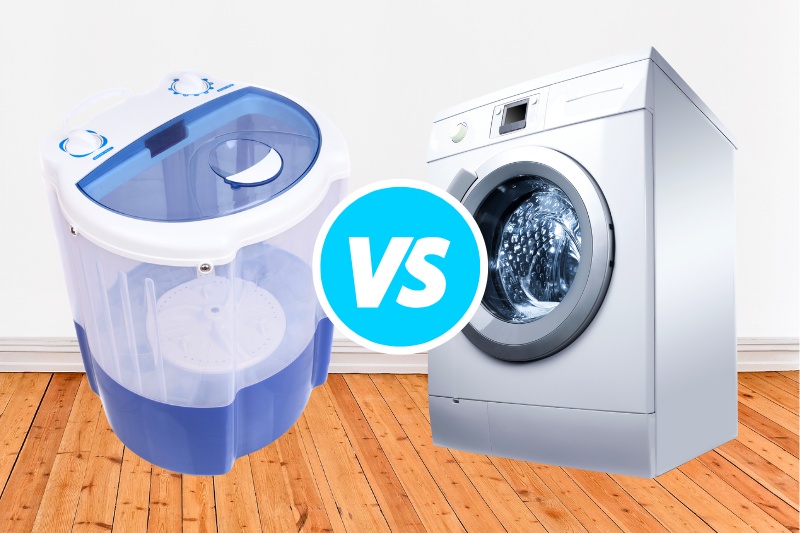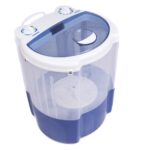Thinking about getting a new washing machine but don’t know if you should invest in a traditional washer or go down the portable washing machine route?
You’re not alone on this one! It’s a dilemma that’s had many people puzzled recently.
Just as well you rocked up here then! Below you’ll find out the main differences between a portable washing machine and a regular washing machine.
By the time you’ve read the vast list of differences, you’ll be able to decide what appliance to buy!
Differences
Plumbing
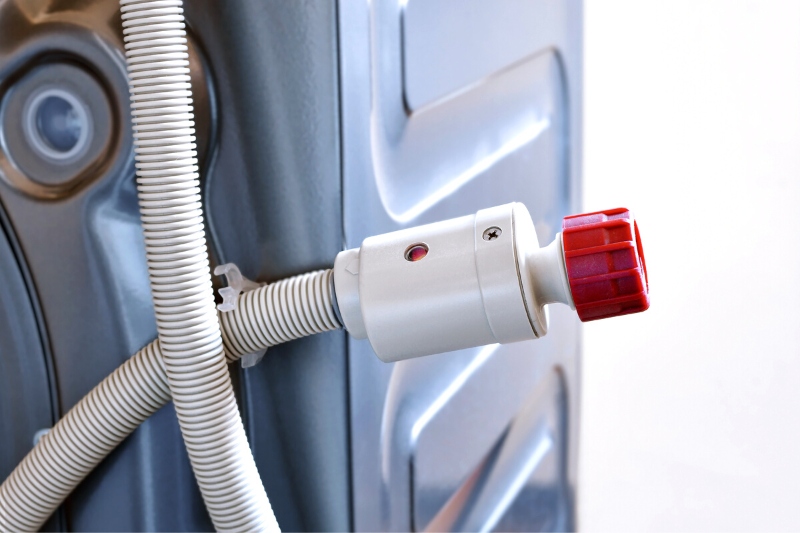
Portable washing machines generally need to be plumbed into some sort of water outlet on a temporary basis.
In most cases, you screw a hose onto a sink’s tap and turn the water on. And you pop the drain hose near a drain so the dirty water can leave the machine.
The bonus with having a temporary plumbing system is that you can move the washer around to various rooms and places and still use it.
It’s incredibly convenient if you’re travelling and don’t always have a specific water point to use.
What’s more, you can also pour water into a portable washer if need be (check your user manual for further instructions on this).
A traditional washing machine, on the other hand, is stationary and remains plumbed in. The washing machine rarely gets moved out of its spot!
Generally speaking, having a washer permanently plumbed in isn’t a big problem if you’ve got space to house your washer. But it doesn’t offer the flexibility of a portable washer.
Tip: Make sure you buy the right attachments to screw your water hose onto your tap!
Electricity
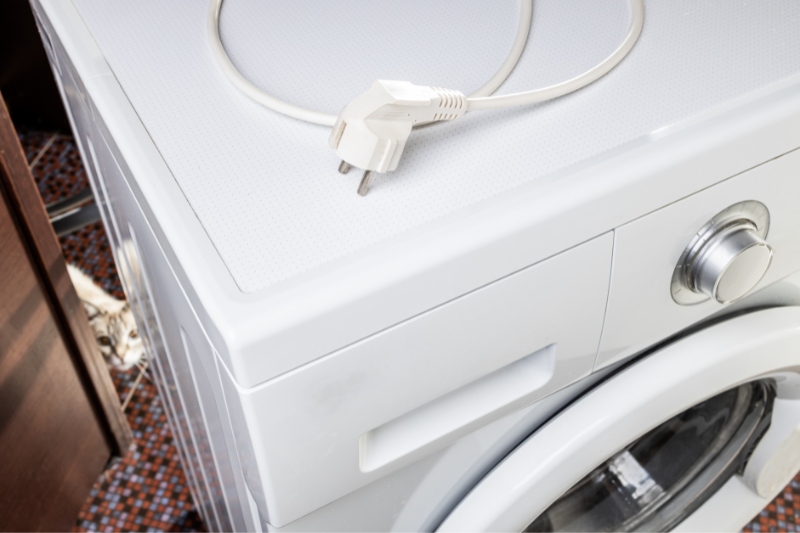
In addition to water, you also need electricity to work a portable washing machine in many cases.
However, you can buy manual portable washers where you have to turn a lever or use a foot pump to agitate the clothes inside the machine. (Quite a useful machine to have around if you don’t have access to an electric hookup when holidaying, for example).
If you’re using electricity, there are no significant issues with using a portable washing machine. But if you’ve got to manually operate your mobile machine, the cleaning task may become tiring, especially if you have lots of laundry to do.
In contrast, a washer must always be hooked up to an electricity point. And if the machine isn’t plugged in, it usually doesn’t work!
Once plugged into a socket, a washer doesn’t need to be unhooked unless you’re cleaning the appliance or need to fix it. Most of the time, you hook the machine up, and that’s how it stays.
The significant difference between the two appliances is that you don’t have to constantly think about electricity and plumbing with a traditional washer, whereas, you do with a portable washing machine!
Physical size
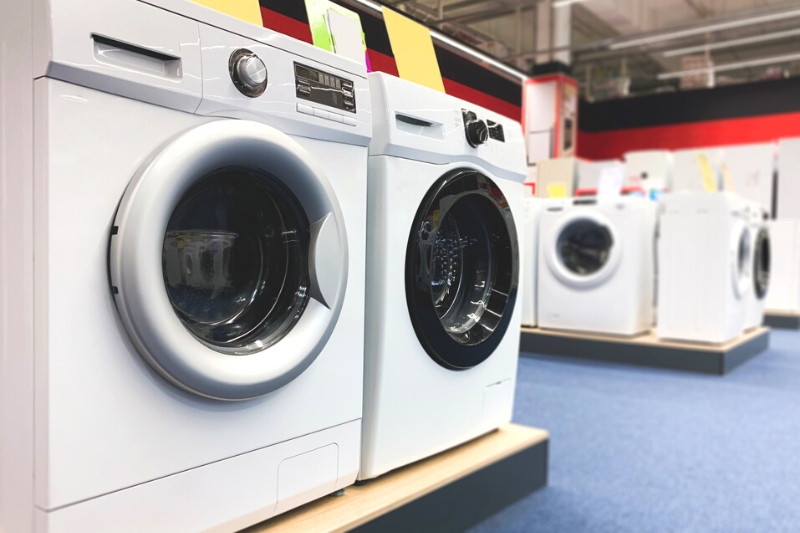
One of the main features of a portable washing machine is that it’s portable (who’d have thought, hey!). But to be portable, it must be light enough to carry around, not too bulky, and an easy-to-carry shape.
Many portable washing machines are under or around 50-70 cm in height (less than half the height of a normal washing machine in many cases), have a boxy shape, and are top-loading.
They also don’t weigh very much. In some cases, they’re as little as 3 kg but can be up to 20 kg!
The small size and weight help with the portability side of things. After all, nobody wants to be lugging a weighty machine around.
The compact size is also perfect if you’re short on space. For example, a portable washing machine would be ideal if you lived on a narrowboat because it wouldn’t take up too much valuable space!
On the other hand, regular washing machines usually come in a standard size (about 85 cm tall, 60 cm wide, and 60 cm deep). And as you’ve probably worked out, that’s much bigger than a portable washer.
It also means that you need quite a lot of space to house the machine, and not every home has this amount of free space. You wouldn’t see a big appliance like a washer in a small caravan or tent, for example. It just wouldn’t be practical!
And just for good measure, manufacturers add a slab of concrete to the button of traditional washers to weigh the appliances down so they don’t go hopping around the place when they’re in action!
This takes the average weight of a washer to about 60-80 kg, but it can be more if you pick a bigger model!
The major difference between the two appliances is that a portable machine is usually light and easy to move about. In contrast, a normal washer is too heavy to pick up and shift around, so it’s stuck in one place (usually the kitchen or utility room).
Loads per wash

Portable washing machines can generally only handle small loads of laundry, about 2-3 kg on average. This may not sound like a lot, but if you’re using these machines when travelling this is an ample amount because you won’t have loads of clothes with you anyway!
You can get larger capacity machines, but of course, they may be heavier, so they’re not as easy to move around.
When it comes to washing machines, you can choose what laundry capacity you’d like your machine to have.
So, if you plan on doing very little washing or lots of it, you can select the correct size machine for you. You can pick a traditional washer with a 6 kg to 12 kg capacity.
The key difference between a portable and regular washer is that even the smallest traditional washing machine capacity (6 kg) will be able to do more laundry in one go compared to a portable washer.
In a nutshell, you’ll be able to wash more clothes at once in a regular washer and won’t have to waste time cleaning laundry throughout the day.
Portability

The most obvious difference between a portable washing machine and a traditional one is that one can be moved around, and the other can’t move around as easily.
As discussed above, portable washing machines are more compact and lightweight so that they can be picked up and taken to various places, like in the caravan, to a festival, and a campsite.
As a bonus, portable washing machine often come with wheels so that you can manoeuvre the appliance around easily.
Traditional washing machines, in contrast, don’t have wheels and aren’t moved very far once they’re in a home. And even if you want to move the washer, you need at least two people for the job because the appliances are incredibly heavy.
It’s very rare for someone to want to move a washing machine a long distance because it’s usually not practical, and you need proper tools to carry out this kind of work! You’re not exactly going to see someone lugging a washing machine around Glastonbury, are you?
The only times you’d need to move a standard washer are if you were moving house, you’d bought a new appliance, you had to move the washer to another room, or you wanted to clean behind the machine.
Most people tend to leave a regular washing machine in one place for a long time and only move it when they have to.
Price
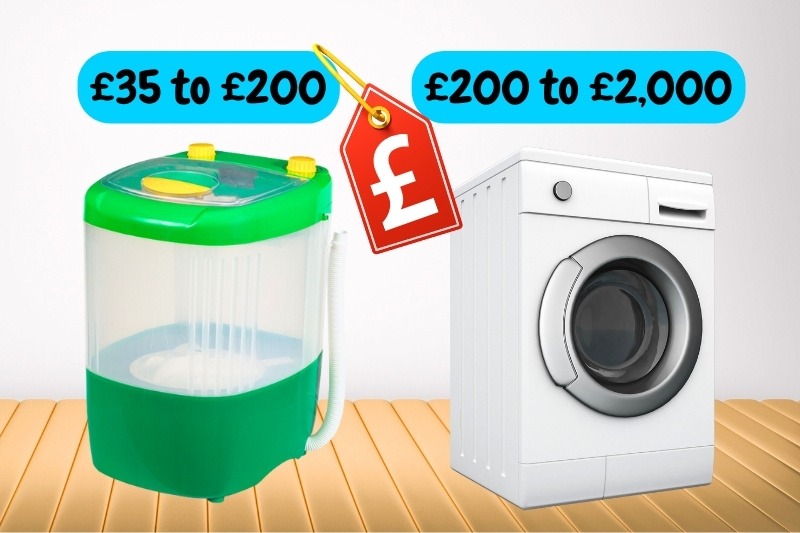
Portable washing machines are significantly cheaper than traditional washing machines. Their prices range from about £35 to £200.
Of course, the more fancy the machine is, the bigger the price tag. But if you just want a basic portable washing machine with a few features that you can pop in the caravan, you’re looking at spending about £100.
Regular washing machines, in complete contrast, tend to start around £200 and go up to over £2,000 in extreme cases!
That’s a mammoth difference between the two and something that needs to be considered before a purchase is made.
You should also consider the cost of delivery too. For example, you may be charged an additional fee to get a washing machine delivered and installed. In comparison, getting a portable washing machine off Amazon might be free if you have Prime.

Features and cycles
Portable washing machines are fairly straightforward when it comes to cycles and features because there generally aren’t many options to choose from.
As a guide, you tend to get a wash timer, function button, and spin timer. Others will come with just buttons that you have to manually turn to select a temperature and spin speed.
There isn’t always a rinse cycle on a portable washer. So, you’ll have to drain and refill the washer with plain water when you want to complete this step.
Although there may not be an excess of features and cycles to choose from, there is a beautiful simplicity to a portable washer.
It’s not really complicated to use! And this not-so-complicated approach is ideal for when you’re travelling or away at uni because you don’t want the hassle of trying to work a machine! Sometimes basic is better.
On the other hand, washing machines (even the most basic ones) come with a wealth of features and cycles that you can choose from.
It’s sometimes nice to have many different settings to pick from because it means you can select a suitable cycle for the type of material you want to clean. Consequently, you can take better care of your laundry.
That being said, with too much choice at hand, there’s room for error. And said mistakes can often be costly, especially if you wash a jumper on the wrong setting!
Cycle lengths
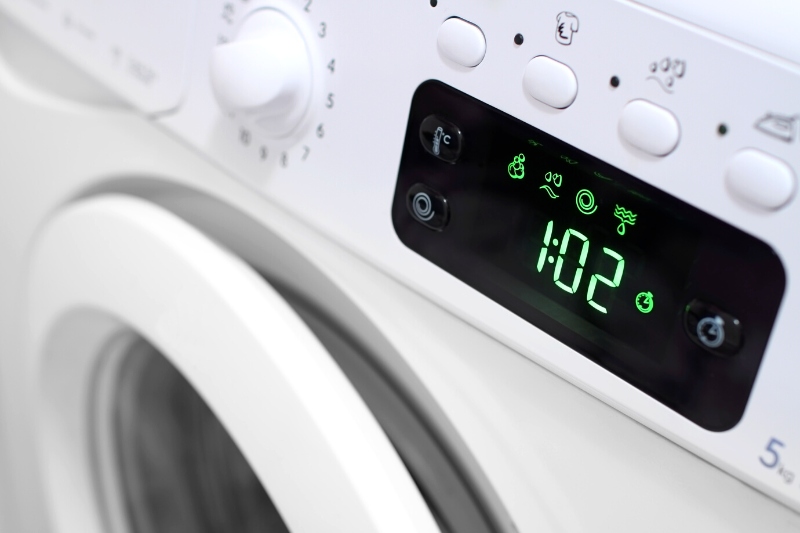
In terms of cycle lengths, portable machines’ cycles tend to be short, a few minutes at a time in most cases.
This, once again, is very handy when you’re out and about, say camping, and you haven’t got time to wait around for long washing cycles to end. The short cycle length means you can return to enjoying your relaxing holiday.
Cycles on traditional washers can be of varying lengths and overly long in some cases. But you can clean more clothes at once, and you get access to more specialised cleaning programs, so it’s not all bad!
Display screen
A portable washing machine tends to have a simple control panel usually made up of dials or buttons. It’s not usually difficult to work out what each button does because the panel is fairly basic, and everything is labelled.
In contrast, washing machines can have a more complex (some would say ultra-modern and more aesthetically pleasing) appearance. They tend to come with buttons, dials, LED screens, and lights, and can even be controlled by a phone.
It’s often a little daunting trying to figure out what each button does as a new user – but you get used to the panel quickly!
However, it’s worth noting that the more complicated the control panel is, the more challenging and confusing it is to operate the appliance, so errors may be made.
Cleaning power
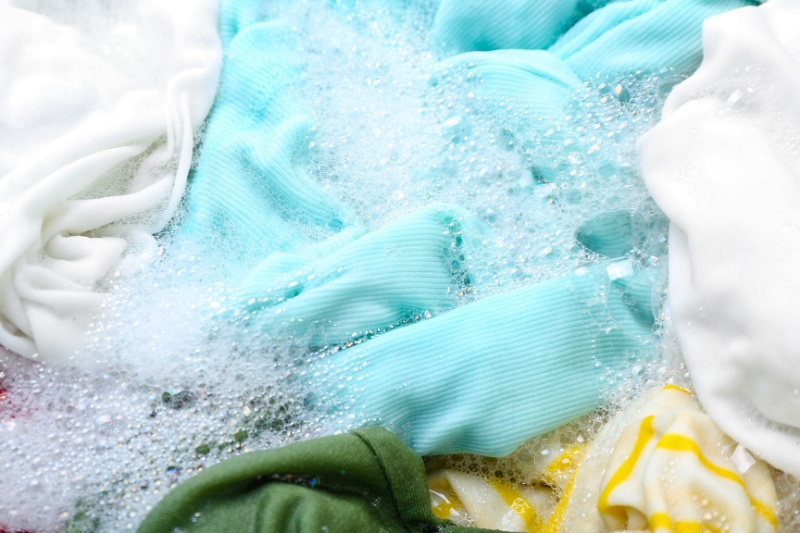
Portable cleaners can clean lightly soiled clothes well. And they’re okay at washing some heavily soiled laundry that have been pre-treated beforehand.
To really reap the rewards of a portable machine, you must only clean little loads at once. Otherwise, you’ll end up with half-washed items or a tub that’s too full and won’t work effectively.
Unfortunately, if you choose a portable washer with a small load capacity, you may not be able to launder all your items in it. For example, the machine may not be able to handle oversized items like towels, bedding, and heavy materials (jeans).
Washing machines can clean more clothes at once, and they can also use more force to clean said laundry. Naturally, because the appliances are plugged into an electricity socket and weighed down, they can use more power and agitation to wash the dirty clothes. And you can also wash larger items like bedding and towels with very little trouble in a washer.
Ease of use
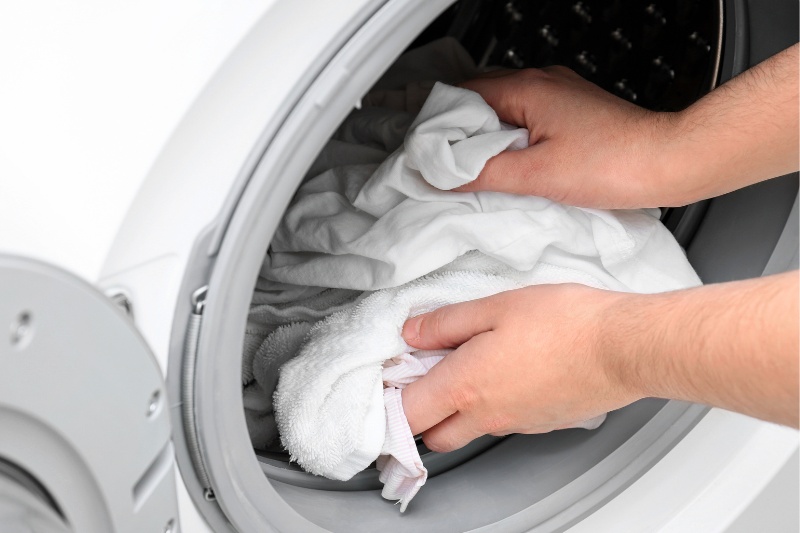
In general, a portable washing machine is easy to use. There’s some setup work that you, the user, have to carry out before and after you use the machine, but it’s not too much work (getting the water into and out of the machine).
The top-loading design of the appliance makes it easy for you to pop dirty laundry into the machine and pull clean washing out. And with only a few buttons to choose from on the control panel, firing up and operating the appliance is straightforward.
However, some things that need to be considered are, 1) You must make sure the drainage hose is plugged into the appliance properly. Otherwise, water might leak out of the machine. 2) You may not be able to use the sink when the water hose is attached to the tap.
On the other hand, a washing machine has more features and a bigger display panel. This can make the appliance more complicated to use to start with. But once you’ve got the hang of using the machine, it’s usually easy to start a cycle.
That being said, once you’ve loaded the washer and chosen a cycle, there’s no real input from the user. The washer just gets on with the cycle – it’s quite straightforward!
Like a portable washer, it’s not too difficult to load the appliance with laundry and remove the washing from it at the end of a washing cycle.
Maintenance
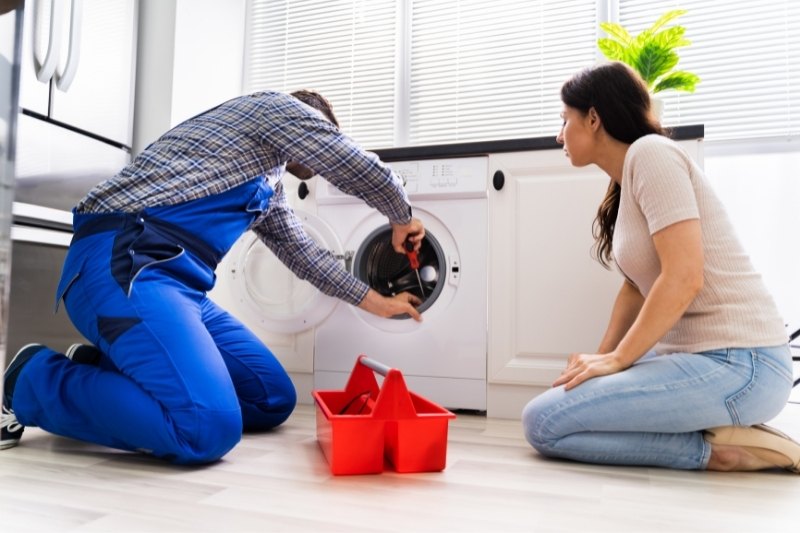
In terms of maintenance, portable washing machines can sometimes be easier to clean because they’re smaller and the parts inside the machine are easily accessible.
It’s great that portable washing machines are easy to maintain because you’re usually out and about camping or boating when you use them. So, you don’t have time or access to as many resources when on the go!
Traditional washers can take time to clean because you’ve got to pay close attention to specific areas and parts within the appliance. Regular washing machines are also bigger, so they’ll naturally take longer to clean.
In addition, you may also have to invest in specific cleaning products for a washing machine and new parts if anything breaks down. These can be costly.
Usability in a busy home
If you live in a busy house, where there’s lots of washing to be done daily, a portable machine isn’t suitable. The machine won’t be able to keep up with your laundry demands.
And when you get around to washing clothes, you may be there for an age getting through all the piles you have.
Getting a traditional washing machine is usually the better option if you live in a busy home. The appliance will allow you to keep up with everyone’s washing demands because the machine will handle bigger loads and wash more laundry at once.
Are you allowed to use the machine?
On a final note, if you live in rented accommodation, you might want to check with your landlord if you can use a portable washing machine. It shouldn’t be a huge problem, but some landlords don’t like you using these machines just in case they leak or make too much noise.
It’s just something that’s worth checking.
Similarities
Both can come with warranties

In most cases, you get a warranty when you buy a portable washing machine and a regular washing machine.
The length of the warranties will vary between the two appliances. And what the warranties cover will be significantly different.
However, buying an appliance with a warranty is always a good idea, just in case something goes wrong. This may mean you have to pay a little more for your machine, but it’s worth it in the long run.
A wealth of brands and models to choose from
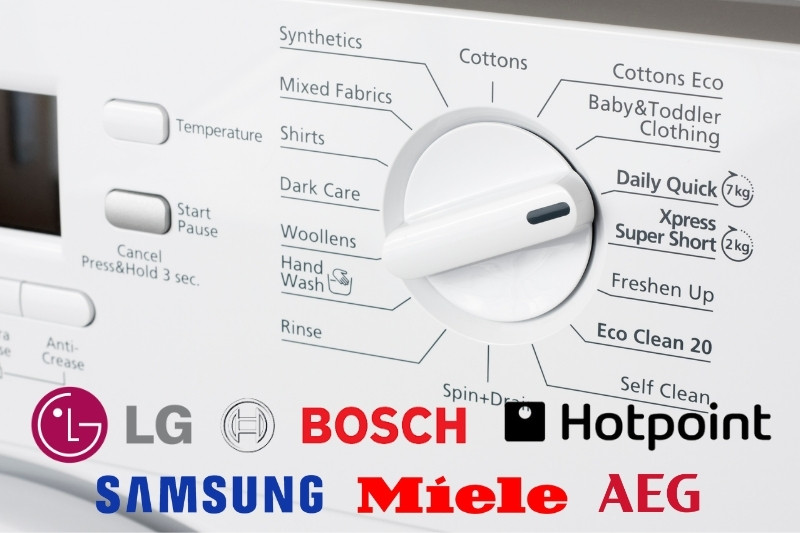
When it comes to getting a portable washing machine or a regular washing machine, there are so many brands and models you can choose from!
In the case of regular washing machines, you can get products from the following well-established manufacturers:
- Hotpoint
- Hoover
- Indesit
- Bosch
- LG
- Logik
- Samsung, and so on!
There are also several portable washing machine models you can choose from. However, portable washing machines generally aren’t made by well-known brands like those household names mentioned above. Therefore, it’s difficult to pinpoint exactly what the ‘best’ brands to choose from are.
You must do your research before you buy a portable washer. Make sure you read up on the product and the company.
Of course, in the case of both machines, the more features and benefits the appliances offer, the greater the price tags. It’s good, however, to know that there are so many versions of each product to choose from, so you can pick an appliance that suits your needs and budget!
Note: When selecting either appliance, always read the product description, read user reviews, ask questions (sales assistant or on a forum), and double-check that you’re getting the best price for the item before you purchase it.
Recap of the Main Pros and Cons of Each Machine
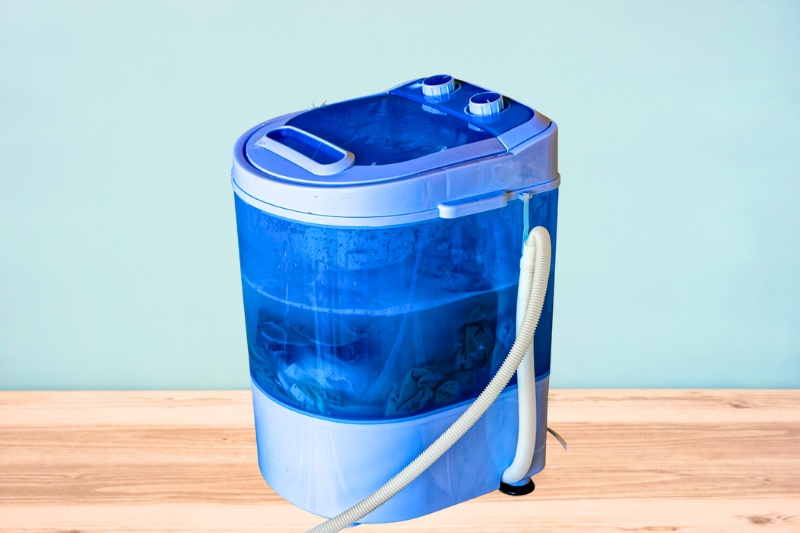
Portable washing machine
Pros
- Can be moved around
- Cheap to buy
- Easy to use
- Cycle times are generally short
- Easy to maintain
- Doesn’t need to be permanently hooked up to a water/electricity point
- Convenient small size – easy to store
Cons
- Won’t clean vast amounts of laundry at once
- Water generally needs to be added manually
- Water usually needs to be drained manually
- Not great at rinsing clothes
- Not suitable for large busy family homes
Regular washing machine
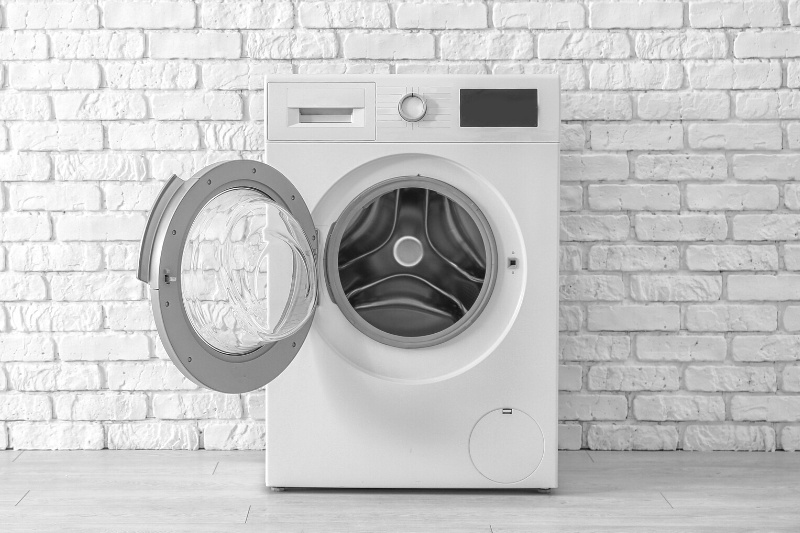
Pros
- Can wash many items at once
- Can wash different materials including heavy items like duvets
- A wealth of cycles and features to choose from
- Better spin speed
- The rinse cycle is present
- Has plenty of power to remove grime from laundry
- When you get used to the machine it’s very easy to use
Cons
- Costly to buy
- Costly to run
- Needs to be hooked up to water/electricity all the time
- Cannot be moved around easily
- A large machine that needs plenty of space
- Cycle lengths vary and can be quite long
- It can be tricky to work out how to use the features and cycles to begin with
- General maintenance may take a little longer to carry out
Should You Buy a Regular or Portable Washing Machine?
There isn’t an exact answer to this question because it depends on your personal circumstances and preferences.

Portable washing machines are great for people who:
- Need something for a small space like in a caravan, a canal boat, or a university bedroom.
- Want to keep running costs down.
- Move around a lot.
- Are environmentally conscious.
- Looking for a cheaper way to do laundry.
- Don’t have access to a launderette/share a busy laundry room.
- For those waiting for a washing machine to be repaired, using a portable machine is a good backup option.
- If you need washing done in a pinch, but your regular washing machines are out of use/busy, you can use a portable washer to clean some items.
- For those who are waiting for their new washers to be plumbed in, using a portable washer as a temporary measure is an option.
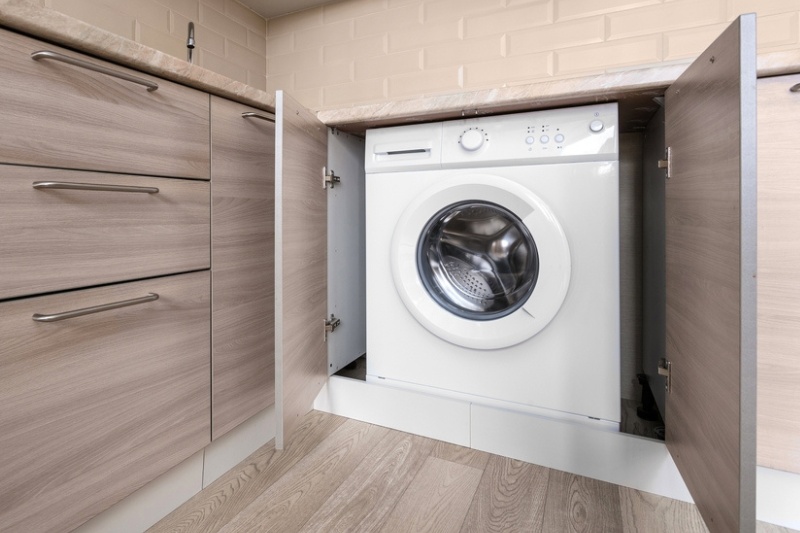
Traditional washing machines are suitable for people who:
- Need to do lots of washing at once.
- Live in a busy family home.
- Have ample space to house a large machine.
- Can absorb the purchasing and running costs of buying such an appliance.
- Don’t mind having the machine hooked up in one place all the time.
- Don’t have a desire to move the machine around often.
In general, a portable washer is helpful when it isn’t suitable or practical for you to have a traditional washing machine.
For example, if you’re away at uni, can’t get to the local launderette, or live in a small flat/caravan. Using a portable washer in these types of cases is far more convenient, space-effective, and cost-effective.
However, a portable washer tends to require more user import and effort to start working, so it may not be as straightforward as you might originally have thought.
The machine also can’t wash as many clothes at once, so you may find yourself cleaning laundry more often.
That being said, a portable washing machine works quite well and can clean clothes to a relatively good standard.

On the flipside, if you come from a busy house where washing clothes is something you need to do every day, you can absorb the costs involved with getting a traditional washing machine, and you have room for one, getting a normal washing machine is the better option.
There are obviously more costs involved with getting a regular washer. Still, they’re usually simple to use (load the drum, select a program, and start the machine), you don’t have to fuss around with the machine too much, and because there’s a wealth of features and cycles to choose from, you can pick one that suits your load!
But, as mentioned above, your unique situation will be the deciding factor!

Bethan has a passion for exploring, reading, cooking and gardening! When she’s not creating culinary delights for her family, she’s concocting potions to keep her house clean!
